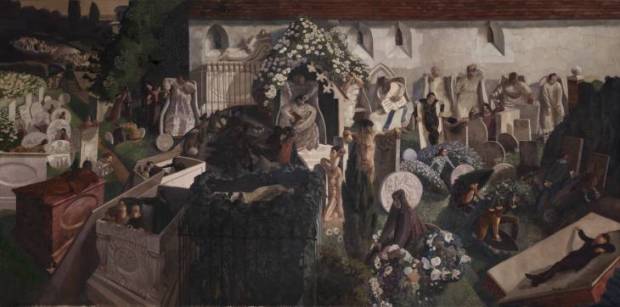Stanley Spencer’s The Resurrection, Cookham 1924-27 uses color and religious motifs to depict a scene of joyful resurrection from death caused by the Great War.
The painting depicts a church graveyard in which a community is rising out of the tombs and coffins. There are mothers taking care of children and husbands, children playing together, men waking up alone. The white church is in the upper right corner of the painting, and along the wall are saints and angels who appear to waking up as well. The upper center of the painting is dominated by a triangular arch of flowers, under which a family of three sits. In the upper left corner of the painting, a river flows in the distance, and a boat full of people is preparing to dock. Some figures are either standing up or lying down with their elbows level with their neck, some with their forearms stretch out and some with their forearms hanging. The overall color scheme is full of white, black, reds, and greens.
Before further analysis, it is important to note that Spencer served in the Royal Army Medical Corp during the Great War, which makes the choice of a graveyard setting more logical However, in contrast to many veterans of the war, the main point of his work appears to be community, happiness, and life. He uses a specific color scheme and religious motifs in the painting—along with, of course, the subtle hint in the title—to indicate that the message of the painting is resurrection.
The dominating colors of the painting are white, black, red, and green. In most Western paintings, white is associated with life, innocence, and purity while black is associated death, corruption, and mourning. The contrasting presence of black and white mirrors the contrast between life and death. Likewise, a similar tension is present in the color red. The color is often associated with blood, which, depending on the context, could be a symbol of life (in the body) or death (out of the body). Green is the color of nature and rebirth, as much of nature dies in the fall before being reborn in the spring.
The religious motifs range from obvious to subtle, alluding to the life, death, and rebirth of Jesus. The eye is immediately drawn to the upper center of the painting, depicting a scene that looks very much like a nativity scene, alluding to the birth and life of Jesus. On a more subtle note, some of the figures are hanging or lying down in a manner indicative of Jesus on the cross, alluding to his death. The graveyard is next to a church—most likely Anglican—which follows the teaching of Jesus, the man who rose from the dead. Additionally, and on a more pagan note, the river scene in the upper left corner could be alluding to the river Styx, which brought souls to the underworld—another symbol of death. Unlike those souls, however, these souls appear to be jovial—a symbol of life. Water is another symbol for rebirth.
Although it is unclear what precisely inspired this community’s rebirth after death, presumably, from the Great War, Spencer’s portrayal of life amidst death is unique among Great War artists.
Sources
Spencer, Sir Stanley. “The Resurrection, Cookham 1924-7.” Tate Britain. Tate Britain, July 2007. Web. 18 Sept. 2013.
“Stanley Spencer.” Wikipedia. Wikimedia Foundation, 25 Aug. 2013. Web. 18 Sept. 2013.

This work is licensed under a Creative Commons Attribution-NonCommercial-NoDerivs 3.0 Unported License.

